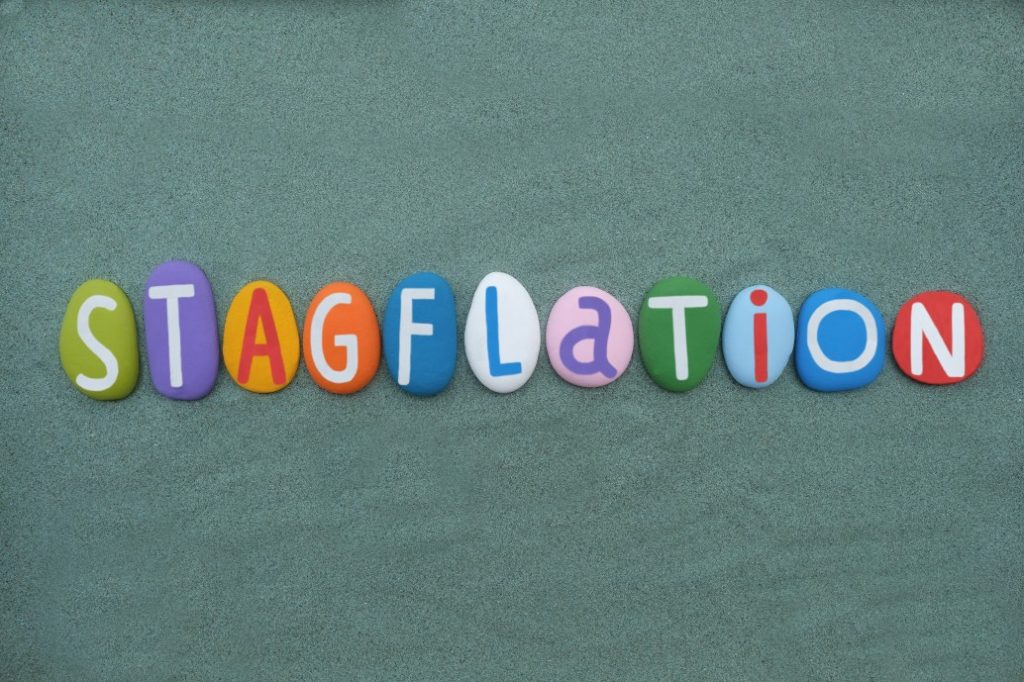The U.S. is currently experiencing the highest inflation rates seen in 40 years. The Consumer Price Index (CPI) skyrocketed to 7.9% this year, meaning there is reduced economic spending. As prices continue to surge, many citizens are concerned that the recovering U.S. economy will reel from the knock-on effects of the war against Ukraine. The country has been forced to place sanctions against Russia, which has caused supply shocks to the nation’s oil usage. Rising fuel costs are causing inflation to climb. There is a high risk the economy will be pushed into a recession as energy prices drive up costs.
What is stagflation?
Stagflation is a period when an economy is suffering from significant macroeconomic troubles. In this scenario, Gross Domestic Product (GDP) is often down, unemployment is high, and inflation is soaring.
Economists use each measure to explain a fundamental part of the economy. GDP is a measure of the country’s total output. It looks at the number of goods and services produced as an indicator of the economic performance in the country. It is a method to investigate how the broader economy is doing in a particular quarter. The unemployment levels in the government dictate how much businesses are producing and how much money is circulating. The job situation in a country will indicate how consumers behave in the market. The measure of inflation explains the movement of prices. It is used to indicate whether there is consumer faith in the currency.

When an economy is functioning well, there are trade-offs with these measures. The relationship between solid GDP growth and low unemployment is inverse. An economy is usually unable to proliferate without suffering from higher inflation. Keeping inflation low will lead to a subdued GDP and higher unemployment in the country.
Stagflation happens when there is both economic stagnation and high inflation. The economy will stall with a decreasing output, and unemployment will rise. This means the three leading macroeconomic indicators are going in the wrong direction.
What happens to the U.S. during Stagflation?
In 1971, President Richard Nixon had to face an oil embargo. He had to introduce quick remedies to stop inflation from rising. The Federal Reserve imposed a 90-day wage and price freeze. This move was meant to help curb the money supply in the economy. It was an attempt to encourage the improvement of American exports. The currency was losing value, so the government took the dollar off the gold standard. These measures allowed the consumers to feel short-term relief. Many historians argue these measures worked to get President Nixon reflected in 1972. The tangled roots of the problem remained until the energy crisis started in October 1973.
The Organization of the Petroleum Exporting Countries (OPEC) placed an oil embargo on the U.S. for their part in protecting Israel. This organization consists of oil-rich nations, which caused a supply shock to the United States. These Middle Eastern countries sought this move to counter the United States’ decision to devalue the currency used to purchase oil. Saudi Arabia led the proceedings, and the effects of the supply shock were immediate and severe for the U.S. It started to cost Americans almost $11.65 per barrel of fuel. An increase of 387% made it very difficult to access power for regular America. There were familiar sights in the country of lines miles-long formed at gas stations. At the time, America was the third biggest oil consumer in the world. This statistic means that its economy was heavily oil-dependent. The U.S. citizens quickly discovered life was difficult without fuel. When the embargo was lifted in March 1974, prices remained 33% higher than before the supply shocks were experienced.
This period of stagflation was caused by countries like the U.S. being over-reliant on oil. This capital misallocation meant that they imported a lot of oil. These conditions were experienced through both high inflation and recession. The CPI had surpassed 10%; this was the highest its been since the 1940s. The GDP was sinking. Unemployment rose from 4.6% to 9% in just two years.
What causes stagflation?
Consumers feel the effects of stagflation when there is both high inflation and high unemployment. A stagnating economy compounds these problems.
The most common reason for stagflation is a negative supply shock. It happens when a fundamental part of the economy faces a bottleneck. A critical economic input will fail in sectors such as energy or labor becoming more expensive. The result is several producers in the economy reduce their production. With less aggregate supply, there is a falling national output. Less output means increased unemployment and higher overall prices.
How can the U.S. solve stagflation?
Policymakers will need to be proactive when dealing with the specter of stagflation. The main problems to solve are high inflation and low growth. These are recession contributing factors that can make things worse.
Less money supply can help reduce inflation. To curb the money supply in the economy, the Federal Reserve may raise interest rates. Increased interest rates hurt economic activity and overall economic growth. It breaks down borrowing, which means less investment in the country. Policymakers will also consider boosting economic growth through government stimulus or low-interest rates. The key is to avoid fueling more inflation.
Stagflation vs. Inflation
The ending of the gold standard leads to decreasing prices and low unemployment. These temporary measures didn’t solve the root cause but helped deal with inflation under robust commodity-backed currency systems.
An unbacked fiat monetary system can cause inflation to persist during periods of economic decline. This stagnation expresses the volatility in the relationship between inflation and unemployment.






































